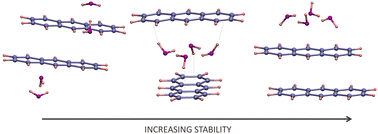A combined theoretical and experimental study of small anthracene–water clusters†
Abstract
Water-cluster interactions with polycyclic aromatic hydrocarbons (PAHs) are of paramount interest in many chemical and biological processes. We report a study of anthracene monomers and dimers with water (up to four)-cluster systems utilizing molecular beam vacuum-UV photoionization mass spectrometry and density functional calculations. Structural loss in photoionization efficiency curves when adding water indicates that various isomers are generated, while theory indicates only a slight shift in energy in photoionization states of different isomers. Calculations reveal that the energetic tendency of water is to remain clustered and not to disperse around the PAH. Theoretically, we observe water confinement exclusively in the case of four water clusters and only when the anthracenes are in a cross configuration due to optimal OH⋯π interactions, indicating dependence on the size and structure of the PAH. Furthermore theory sheds light on the structural changes that occur in water upon ionization of anthracene, due to the optimal interactions of the resulting hole and water hydrogen atoms.



 Please wait while we load your content...
Please wait while we load your content...